Order Management System for Small Business: Why You Need One and How to Choose

If you’re running a small business, like a cake shop or flower shop, a spreadsheet to handle your orders usually works fine. Until the big holidays hit.
Say, Mother’s Day or Valentine’s Day, orders flood in and suddenly your spreadsheet can’t keep up. Details slip through sticky notes and files, leading to missed orders, wrong deliveries, or mixed-up requests. And of course, it happens on the one day you finally get booming business. Frustrating, right? It’s costing you both your customers, and your reputation.
You tell yourself you’ll do better next holiday. But then it happens again…
The truth is, a spreadsheet just isn’t built for this. That’s when most business owners start searching for an order management system.
But, the choices are just…. endless. From DIY tools to ready-made software. So which one is right for you?
This article will explain what an order management system is, the different types available, and how to choose the best fit. That way, you can stop stressing over orders and start focusing on growing your business.
What is an Order Management System (OMS)?
When it comes to inventory and sales, the order process is the “sales” part. It covers everything from the moment a customer places an order to the moment the product arrives at their door (or the service is done). It also connects closely with purchasing and inventory management.
That’s why many businesses use an order management system. It works like a central hub that keeps your orders, inventory, and shipping details in one place, so you don’t have to dig through notes or spreadsheets. With everything organized, orders get processed smoothly, shipped on time, and nothing slips through the cracks.
How Small Businesses Can Track Sales Orders
At the most basic level, an order management system handles orders and products. You’ll get a clear list of every order with key details upfront—customer name, shipping info, and status. Open one, and you’ll see the full breakdown: items purchased, prices, shipping costs, and the total amount.
Every order records the products a customer buys. That’s why an order management system usually includes a product sheet as well. This keeps all your product details like items, prices, and current stock in one place.
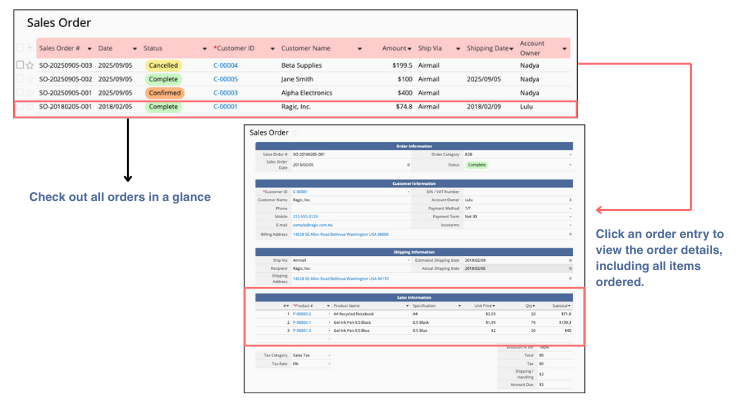
When you create a new order, you can simply select the product and instantly check if there’s enough inventory. That way, you avoid overselling or running into out-of-stock problems.
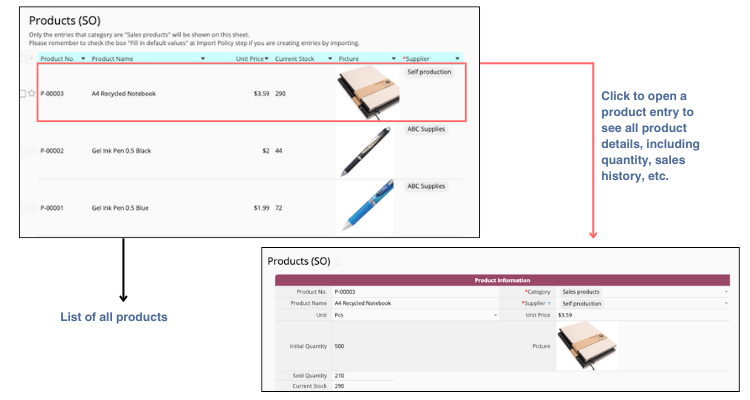
‘Order’ Sheet and ‘Product’ Sheet: The Foundation of an OMS
Basically, once you have an ‘Order’ sheet and a ‘Product’ sheet, you’ve got the foundation of a simple order management system. It helps keep order processing organized and reduces mistakes.
So what exactly are the benefits of using an order management system? Let’s take a look at the concrete advantages it can bring.
Benefits of Using an Order Management System for Small Business
1. Link Orders to Product Details for Faster, Accurate Processing
Without an order management system, order and product information often gets scattered across Excel files or spreadsheets. Staff have to manually enter what each customer ordered and in what quantity—a slow, error-prone process, especially for large or complex orders or products with long names.
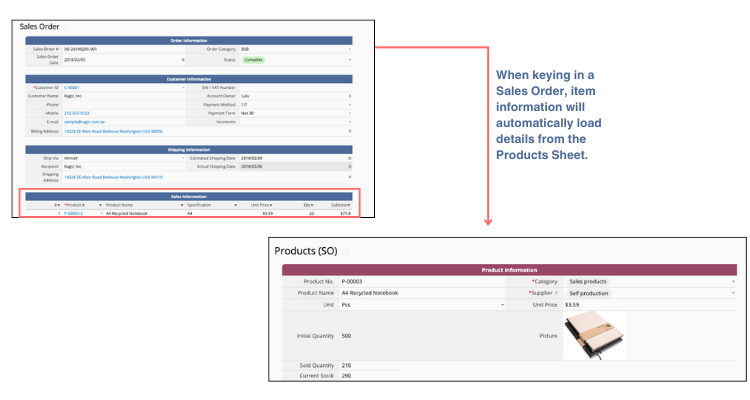
With an order management system, orders and products are linked. You can select items directly from the product list when creating a new order—way quicker than manually typing all the product information, and keeps every order accurate.
2. Track Order Status to Ensure On-Time Delivery
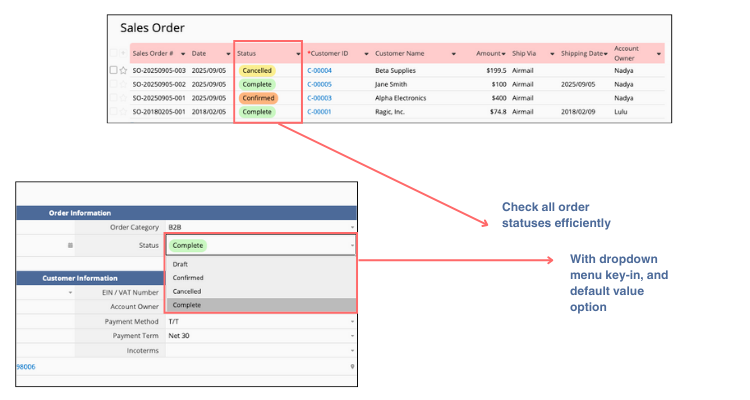
The heart of an order management system for small businesses is making sure every order reaches the customer smoothly. That means knowing exactly where each order stands—is it new, in progress, shipped, or canceled? Using paper or Excel makes it easy to lose track or make mistakes, which can disrupt shipping schedules.
With an order management system, you can set up order statuses in advance. Staff can quickly update each order as it moves through different stages, reducing manual errors. This way, you can track orders online at a glance, ensuring nothing gets overlooked and every delivery stays on time.
3. One-Click Inventory Updates for Accurate Stock

Managing orders in Excel often means juggling separate files for orders and products. Since the files aren’t connected, you have to manually update inventory every time you ship an order. What if you forgot to update and you disrupt your whole inventory count?...
With an order management system, orders are linked directly to your product list. Shipping an order automatically adjusts your stock with just one click. This eliminates manual entry, so you reduce mistakes.
4. Know Your Best Sellers Instantly with Built-In Reporting
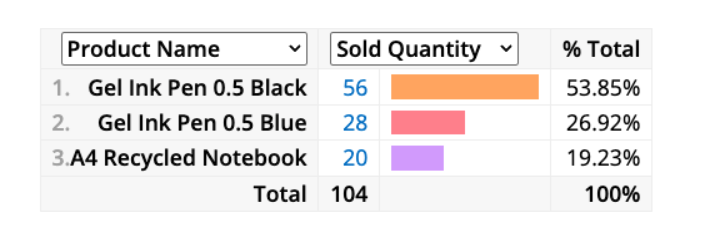
Which products sell the most? With only a few items, it’s easy to tell. But as your catalog grows, tracking sales with paper or Excel means digging through files and crunching numbers by hand. It sounds time-consuming, so you’ll probably put it off, telling yourself it’s “not that urgent.” Instead, you’ll rely on gut feelings about your best sellers. And most of the time, those guesses aren’t accurate.
With an order management system, all sales data is recorded automatically as orders come in. Want to know your top sellers? Open the system, and the numbers are clear at a glance. Built-in reporting tools can even visualize sales rankings, helping you understand customer preferences, plan targeted marketing, and boost sales.
Choosing an Order Management System – What Are Your Options?
There are plenty of options on the market, you can either develop from scratch or buy an off-the-shelf software, each with its own pros and cons. Here’s a breakdown of the most common types:
1. Build Your Own System with Excel VBA
If you have someone on your team familiar with VBA, you could create a custom order management system right in Excel. The biggest advantage is flexibility. You can design it to match your exact workflow, often at a lower cost than buying software.
But, maintaining and updating the system can be tricky, especially if the developer leaves. Excel VBA has limited functionality, making it hard to support complex order processes. As your business grows, maintenance can become time-consuming, and scalability is limited.
2. Custom Development for Highly Specific Needs
For businesses with highly specific needs, a fully custom system is an option. This can be done either with an internal team or by hiring an external developer.
Internal development ensures the system fits your workflow perfectly and gives you full control over technical details—but you need the right in-house expertise. External development lets professional vendors build a tailored solution and integrate it with ERP, CRM, or other tools, reducing internal workload.
The trade-offs? Custom projects take longer, cost more, and require ongoing technical maintenance. This approach is best for companies with bigger budgets and highly customized system requirements.
3. Traditional Off-the-Shelf Software for Standard Workflows
If you want a system that’s ready to go with standard features, traditional software packages are a solid choice. These products are proven in the market, provide standardized order management workflows, and often include technical support and updates.
Cons is: flexibility is low. If your order processes are unique, off-the-shelf software may not fit perfectly. Many traditional systems require local installation on servers or computers, making remote access and collaboration harder. Plus, initial costs can be high, and ongoing maintenance or upgrades may add to expenses.
4. Cloud-Based Software
Cloud solutions are becoming increasingly popular. They’re easy to deploy, require no installation, and can be accessed anywhere—perfect for remote or multi-location teams. Many use a subscription model, which lowers upfront costs and eliminates the need for local server maintenance.
The main limitation is customization. Like traditional software, cloud solutions often offer limited flexibility. If your order processes are very specific, you’ll need to check whether the system can meet your needs.
5. No-Code Platforms (Like Ragic) for Easy, Customizable OMS
If your workflow isn’t standard but you don’t have development resources, a No-Code platform like Ragic is a great option. These platforms offer intuitive interfaces and ready-to-use templates, so you can build a system without programming skills and customize it to your needs. They also often integrate with other tools, making them highly adaptable to unique workflows.
If the templates don’t fully fit your business, most platforms provide tutorials, guides, or customer support so you can build your system yourself. And if you don’t have time or experience, many platforms offer partner services to help you quickly set up a system that works.
How to Choose the Right Order Management System (OMS) for Your Business
There’s no one-size-fits-all when it comes to order management system. The right choice depends on your budget, workflow flexibility, IT resources (do you have a tech team?), remote work needs, and future scalability.
- If your workflow is fairly standard and you have a solid budget, traditional software can work well.
- If you need remote access or multi-location support, cloud-based software is a better fit.
- For highly customized systems and enough budget, custom project development lets engineers build a system tailored to your exact needs—but it’s more expensive and takes longer to implement.
If your workflow is flexible and off-the-shelf software doesn’t fit, but project development is too costly, you can choose based on your tech resources:
- If you have an IT team or programming skills, building a system in Excel VBA is an option.
- If you lack technical resources, a No-Code platform is ideal. You can create and adjust your system without programming, giving your business the flexibility it needs.
Ragic, for example, is a flexible No-Code platform with a variety of order management templates. Whether you just need a simple sales order template or a full inventory and order management template covering orders, customers, products, stock, and purchasing, you can pick a template and customize it to your workflow—no technical background required.
Do You Still Need an Order Management System If You Use an E-Commerce Platform?
Many businesses sell across multiple e-commerce platforms. While each platform has its own system to manage orders and inventory, handling orders across different platforms often means constantly switching between dashboards and manually consolidating data. This is time-consuming, error-prone, and can lead to overselling or stockouts, affecting shipping efficiency, reputation, and customer satisfaction.
When you sell on multiple channels, a dedicated order management system becomes essential. It centralizes orders from all platforms and synchronizes inventory, preventing mistakes and improving shipping efficiency. Ragic, for example, can connect to major e-commerce platforms via API and supports Excel imports, allowing you to integrate orders, manage inventory, and create a system tailored to your needs.
Another challenge is that e-commerce platforms frequently update their backend features and formats. Some ERP systems can’t keep up, causing order and inventory data to fall out of sync. Ragic’s flexibility is a key advantage—it lets you quickly adjust fields and settings, respond to changes, and ensure smooth, accurate order and inventory management.
See also
Category: Applications > Templates



